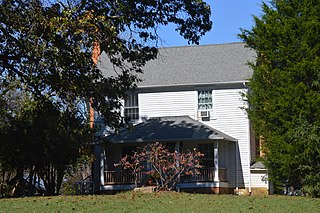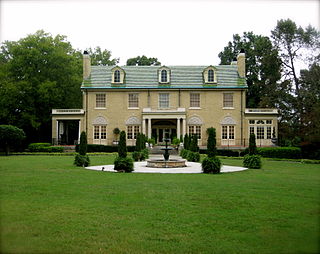The White House, also known as H. H. Sofley House, is a historic home located at Huntsville, Yadkin County, North Carolina. It was built about 1795, and is a two-story, heavy timber frame, Early Republic / Late Georgian style dwelling with a Quaker plan. It has one-story rear frame additions dated to the late-19th and early-20th century. The front facade features a double-tier, full-width shed porch.

Jackson Park Town Site Addition Brick Row is a group of three historic houses and two frame garages located on the west side of the 300 block of South Third Street in Lander, Wyoming. Two of the homes were built in 1917, and the third in 1919. The properties were added to the National Register of Historic Places on February 27, 2003.

Edward R. Wilson House, also known as the W. H. Schultz House, is a historic home located at Newark, New Castle County, Delaware. It was built about 1860, and is a three-story, gable-roofed frame dwelling with a porch running across its facade, north endwall, and rear elevation. It has a two-story brick wing built about 1900, and a later frame wing extending from the rear of the brick addition. It is in the Greek Revival / Italianate style. Since 1907, the house is part of the University of Delaware Farm, an agricultural experiment station managed by its College of Agriculture. The house was used as a dormitory during the 1980s and has since been repurposed to serve as offices for the College of Agriculture and Natural Resources at the University of Delaware.
King-Freeman-Speight House, also known as Francis Speight House, is a historic plantation house located at Republican, Bertie County, North Carolina. It was built in two sections, with the oldest built between 1808 and 1828. The older section forms the basis of the current rear wing. About 1828, a 2+1⁄2-story, Federal style, side-hall plan was added at a right angle to the original structure. The house was enlarged and remodeled in 1907. It has a two-story, two-bay addition and a two-story rear addition built in 1855. It features a hip roof front porch. Also on the property are the contributing two smokehouses, the kitchen, and an office. Noted landscape artist Francis Speight was born in the house in 1896.

Magnolia Place is a historic home located near Morganton, Burke County, North Carolina. The original section was built about 1818, and is a two-story, five bay by two bay, brick structure in the Federal style. Attached at the rear is a one bay by two bay temple form Greek Revival style addition built about 1850. It features a long full-height porch. The addition was built by Clarke Moulton Avery, second child born to Isaac Thomas Avery, master of Swan Ponds. In 1841, he married Elizabeth Tilghman Walton, daughter of Thomas George Walton, master of Creekside.
George E. Barnhardt House is a historic house located near Mocksville, Davie County, North Carolina. It is locally significant as a rare surviving example of a post-American Civil War brick farmhouse in Davie County.

The Clarke–Hobbs–Davidson House, also known as the Masonic Temple and Charles A. Hobbs House, is a historic home located at Hendersonville, Henderson County, North Carolina. It was built about 1907, and is a two-story, brick, transitional Queen Anne / Colonial Revival style dwelling. A rear brick addition was built about 1958, after it was acquired by the Masons for use as a Masonic Lodge. It features a one-story hip roofed full-width porch and a tall deck-on-hip roof.

Eagle Nest is a historic plantation house located near Pink Hill, Jones County, North Carolina. It was built about 1800 and is a two-story, four-bay by three-bay, Federal style frame dwelling. It rests on a brick foundation, is sheathed in weatherboard, and has a gable roof with exterior end chimneys. It has two one-story frame rear additions. The front facade features a two-tier engaged porch with an enclosed east end. Also on the property is a contributing smokehouse.

Robert L. Blalock House is a historic home located at Kinston, Lenoir County, North Carolina. It consists of the original two-story, three-bay, double-pile, side-hall-plan Greek Revival style main block dated to the 1850s, and a large, two-story rear ell. It has a one-story gable-roofed wing and a small shed-roofed room north of the rear ell and a complex arrangement of one- and two-story additions and enclosed porches to the south. The house was renovated in the 1920s in the Classical Revival style. It features a full-width front porch supported by groups of square-section brick columns with a round corner pavilion and porte-cochère. It has housed a funeral home since 1947.

Cedar Dell, also known as Kennedy Memorial Home, is a historic plantation house located near Falling Creek, Lenoir County, North Carolina. It was originally constructed about 1820 as a two-story, three-bay, Federal style brick dwelling with a side-hall plan. It was enlarged to five bays wide and converted to a Victorian Gothic central hall plan mansion. The front facade features a one-story Eastlake-style porch with a low roof topped by a wrought iron balustrade and the rear facade has a two-tier porch. Also on the front facade is a large bay window with a roof identical to that on the porch. The house and property were deeded for use as an orphanage in 1912.

Carson–Young House is a historic home located near Marion, McDowell County, North Carolina. It was built about 1860, and is two-story, three-bay, frame I-house with Greek Revival style design influences. A one-story, hip-roofed rear addition was built about 1951. It features a central, one-bay-wide, two-story porch is capped with a full pediment roof. Also on the property is a contributing two-story, brick schoolhouse and barn.
Sidney and Ethel Grier House is a historic home located near Charlotte, Mecklenburg County, North Carolina. It was built in 1916, and is one-story, three-bay, vernacular Bungalow / American Craftsman style farmhouse. The house sits on a brick pier foundation, clapboard siding, and has a hipped roof with dormer. It has a 1+1⁄2-story recent rear addition. It features a wraparound recessed porch, supported by eight tapered half-posts on tall brick piers.

Holloway-Jones-Day House, also known as the Day House, is a historic home located near Roxboro, Person County, North Carolina. It was built about 1840, and is a two-story, Federal style frame farmhouse. A rear ell and hip roofed front porch with Italianate style decorative elements were added in the mid-19th century. It has brick gable end chimneys, front and rear transoms, a hall-parlor plan and a fieldstone cellar.
Kenneth McKinnon House, also known as the McKinnon-McArthur-Kinlaw-Johnson House, is a historic home located near St. Pauls, Robeson County, North Carolina. It was built about 1840, and is a two-story, timber frame dwelling with Greek Revival style interior design elements. It rests on a brick pier foundation, has a side-gable roof, and exterior end chimneys. At the rear is a one-story end-gable kitchen/dining room addition. The front facade features an overhanging second story, thereby creating a full-width, recessed first-story porch.

Wood Grove is a historic plantation house located near Bear Poplar, Rowan County, North Carolina. It was built about 1825, and is a 2+1⁄2-story, three-bay, Federal style brick dwelling. It sits on a stone foundation, has a hipped roof front porch, and one-story rear kitchen ell.
Murphy-Lamb House and Cemetery is a historic plantation house located near Garland, Sampson County, North Carolina. The house was built about 1835, and is a two-story, five bay by two bay, single pile Federal style frame dwelling. It has a brick pier foundation, side gable roof, and engaged front porch with a shed roof and engaged rear shed. The interior follows a hall-and-parlor plan. Also on the property is the contributing family cemetery. It is identical in form to the Samuel Johnson House.
Samuel Johnson House and Cemetery is a historic plantation house located near Ingold, Sampson County, North Carolina. The house was built about 1840, and is a 2+1⁄2-story, five bay by three bay, single pile Late Federal style frame dwelling. It has a brick pier foundation, side gable roof, and engaged front porch with a shed roof and engaged rear shed. The interior follows a hall-and-parlor plan. Also on the property is the contributing family cemetery. It is identical in form to the Murphy-Lamb House.

John C. Sikes House is a historic home located at Monroe, Union County, North Carolina. It was built in 1926–1927, and consists of a 2+1⁄2-story, five bay by four bay, Classical Revival style main block with a two-story rear ell. The house is constructed of yellow Roman brick and has a gable roof. The front facade features a parapeted portico supported by six stone Tuscan order columns.

Dr. Hubert Benbury Haywood House is a historic home located at Raleigh, Wake County, North Carolina. It was built in 1916, and is a two-story, Prairie School-style brick dwelling with a green tile hipped roof and two-bay wide, one-bay deep, one-story brick sun porch. A two-story rear ell was added in 1928. The interior has Colonial Revival style design elements.

Davis-Whitehead-Harriss House is a historic home located at Wilson, Wilson County, North Carolina. It was built in 1858, and renovated in 1872 in the Italianate style. It is a two-story, three bays wide, "T"-plan, frame dwelling, with a rear ell. It has single-shouldered, brick end chimneys with stuccoed stacks and a one-story, hipped roof front porch. Also on the property is a two-story frame carriage house built in 1925.

















